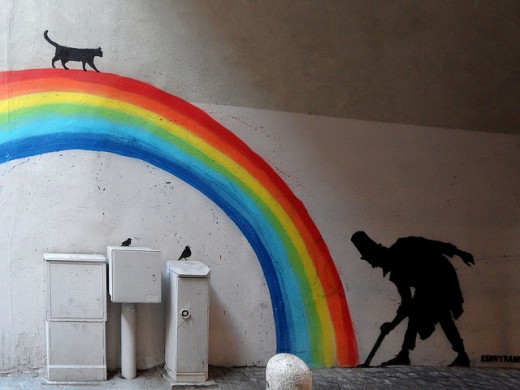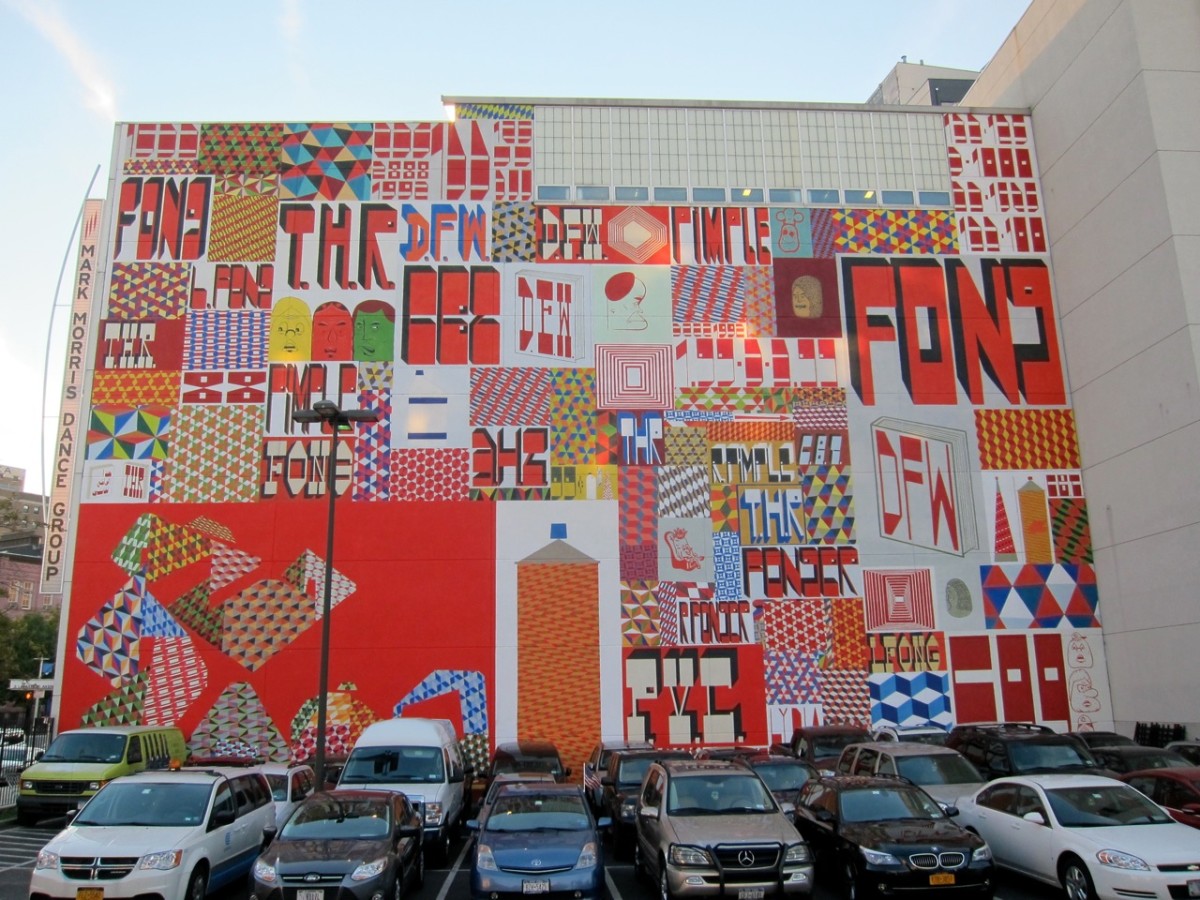Painting Wall Murals: Choosing the Right Paints, Primers, and Finishes
Painting Wall Murals: Choosing the Right Paints, Primers and Finishes
Whether you’re planning to paint your first mural or your hundredth, one of the most important choices you can make is the materials you actually put on the walls. From primers and prep work, to paints and paint mediums, to the final, protective coatings, it’s not always such a clear-cut choice.
There are four basic, important considerations when choosing paint and other such substances:
- The material on which the mural will be painted
- How long you want it to last
- The location of the mural
- Your budget
Consider your options carefully so you can make an informed choice and get the supplies that best suit your needs.
Surface Preparation
A vital step in mural painting is to ensure the surface is properly prepared, or all your hard work may be a waste of time. A poorly prepared surface will only accelerate the rate of deterioration of your mural. After repairing, sanding and cleaning your surface so it’s in good form for painting, you’ll need to put on a preparatory coat to give you smooth, even coverage.
Primer is a safe an inexpensive option for most home murals. Use primer anywhere you would normally use interior or exterior house paints. Acrylic primer is durable enough to give you superior coverage and good surface adhesion. It’s best to paint a mural on unpainted surfaces or surfaces that have been stripped of previous paint, but acrylic primers can be used over oil-based or latex-based paints if necessary. Be sure to choose interior primer for indoor murals, or exterior primer for outdoor murals, as the case may be.
You can save a few dollars using an all-purpose latex primer, though acrylic will stand up better in the long run and can be worth a few extra bucks. But for a mural in a baby’s room that will probably be repainted in the next five years, or in an apartment you expect to be moving out of within a couple of years, inexpensive latex primer will suffice.
Oil-based primers have no real advantage, and too many disadvantages. They’re harder to clean up, emit stronger fumes and take longer to dry. As such, they’re not recommended.
Shellac and enamel primers are not generally necessary unless your interior wall needs some serious stain-blocking or odor-blocking abilities. This kind of coverage may be necessary when repainting after a smoker moved out or if painting a wood wall that contains tannins that may bleed through. Unless the conditions are extreme they are generally unnecessary. Avoid using them outdoors; these hard coatings don’t contract and expand with temperature and moisture fluctuations, so they can cause cracks in your mural paint pretty quickly.
Masonry primer/sealers are the best options for preparing brick, cinderblock or cement walls.
Finally, gesso is a type of surface preparation substance artists typically use on canvas. Some muralists recommend gesso in lieu of house paint primers; however gesso is a costly product in comparison. The only situation in which it would be worth the extra cost would be if painting the mural on canvas, fabric or some such porous, uneven surface. Otherwise, house paint primers will generally suffice.
mural

Painting Wall Murals : Choosing the Right Paints
Paints
The type and quality of paint you choose will largely depend on your budget and how long you want your mural to last. Paints can cost anywhere from under $1 for a small craft paint or paint sample, to over $100 a gallon for high-quality professional mural paints.
Latex House Paints (interior or exterior) have their benefits. They are cost effective— you can get a gallon for under $15, or samples (for smaller details and designs) for a couple of dollars. If you’re not too picky about color, you can ask friends and neighbors to donate what they have lying around the garage, or you can check with your local dump’s recycled paint program where you can walk away with whatever anyone else dropped off, free of charge. Indoors, they last a few years before fading (barring exposure to direct light or high traffic areas where the walls get touched a lot).
The drawbacks are that they’re hard to use for blending and shading. Unless you’re going for a cartoonish style, this can be a very frustrating paint to use. If you want to use a paint sprayer, you will have to dilute it, which will make it even less durable. Outdoors, it won’t likely last many years without fading, peeling or cracking.
When working with house paints, a light sheen produces best results. Choose paints in an eggshell or satin finish. Matte paints can be very difficult to clean, and can easily get soiled or stained. Semi-gloss and glossy paints are so shiny and reflective they can cause harsh glares where the light hits the surface.
Acrylic paints are more durable than plain latex, easy to work with, and there is a type to fit every budget. Even the lowest quality acrylic craft paints will suffice and last for years indoors. Acrylic house paints (eggshell or satin finish) can be used just like latex house paints. Artist quality acrylics, which have better pigment, will last for a decade or two with proper care. High-quality muralist acrylic paint — preferred for outdoor murals or murals you want to last for many decades — are moisture-resistant and light fast.
Acrylics have better coverage abilities than latex, and since they’re both water-based polymer paints, they are completely compatible and safe to use together. It can be cost effective to paint the backdrop or large blocks of color with latex, and use acrylic for smaller images and details.
One caveat about acrylics: they dry quickly. In many cases this is a plus, except when it dries before you’re finished with it.
Work in sections, and work fast. Use a little paint at a time to prevent it from drying out on your palette or developing a “skin” if in a container. Finally, clean your brushes immediately.
Oil paints are not generally recommended for mural painting. Though oil paints are known for blend beautifully, on walls they take far too long to dry and cure to ever be practical for murals. This is especially true of thick, artist-quality oil paints. If you must use oil paints, use oil-based house paints with oil-based primers.Don’t mix them with acrylics or latex paints, which are water based. Be aware that you’ll need a solvent to clean up.
Rather than oil, consider using enamel acrylic paints instead. They have a hardening coat and dry glossy, and are suited to last.
Paints that should be avoided altogether include poster paints, tempera paints and watercolors. Even indoors, they are too delicate to stand up to the test of time at all.
Creative Mural

Painting Wall Murals : Mediums
Mediums
Paint mediums are not always necessary, but occasionally they can help you get the job done.
Texture medium, for example, can thicken your paint if you find the brand you bought too runny, and you’re getting a lot of drips. There are also Thinning mediums if you find you purchased paint that is so thick that you’re having a hard time getting it to flow and spread easily. Retarder mediums are an excellent option for those working with fast-drying acrylics; the additive slows down the drying time of the paint to give you more time to work with it.
Glazes can be useful when mixed with paints for more translucencies, making shadings and highlights more subtle. They are also perfect to give your paint a faux age look or blend colors subtly.
Painting Wall Murals : After Coats
After Coats
In most cases, your mural will benefit from some type of protective coating. This is especially true if you want it to last for decades, if you used low quality paints like latex, if your mural is exposed to high traffic areas (such as a classroom) or the elements (outdoors). One or two coats will suffice.
Use a varnish or an acrylic sealer to protect the surface once the paint has fully cured. Make sure that the product you purchase is compatible with the type of paint that you used and suitable for the type of surface you are covering.
For best results, look for a protective coating that is clear, non-yellowing and offers UV protection. It must especially be able to stand up to moisture if outdoors.
Like with house paints, consider the finish. A matte finish coating will not create additional glares or make a surface look unnaturally shiny. If you want shiny, for an almost glass-like effect, go for the glossy varnishes.
Final Recommendations
If you’re painting a single mural in your own home or place of business, and you have limited experience as an artist, the safe bet is to stick with the easy-to-use, budget-friendly products: water-based primer, water-based house paints or craft paints, with a clear acrylic sealer or water-based varnish. These can produce solid results without a huge investment and without taking a risk with unfamiliar products. Over-complicating the job with unfamiliar products can end up with more frustration and waste than it’s worth.
If you’re going into business, it pays to familiarize yourself with a variety of products. Take some time and experiment with a product before offering it to your clients.That way, you can offer your customer’s options based on their budget and needs, and feel confident working with the different products available.
Romi Cortier Design: Art Deco Wall Mural - [How to & Art History]
My Art and Wall Mural Hubs
Mural








